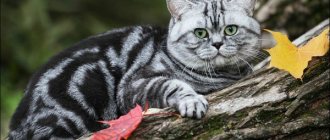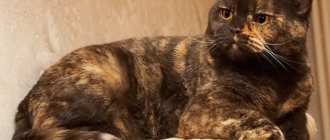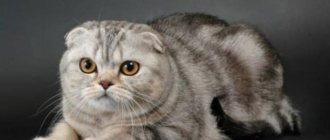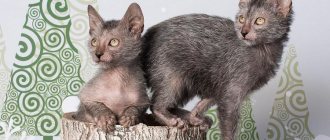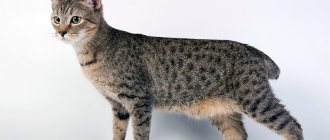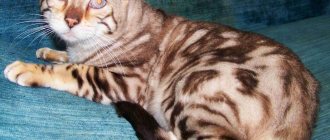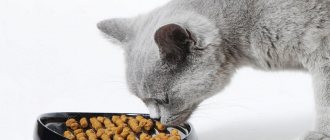Save article:
Bobtail cats
- hunters with excellent qualities, owners of such strong long hind legs and an amazing sense of balance, differ from other cats in the absence of a long tail.
The originality of appearance and friendly character traits have made tailless breeds desirable in many homes around the world.
In general, cats without a tail are divided into Manx and Bobtail cats. And these two groups are divided into subspecies.
There are many versions about how such beautiful cats were born. According to one hypothesis, cats with short tails appeared in the Land of the Rising Sun BC. Much water has passed under the bridge since then, and Japanese Bobtails became an officially recognized breed only at the beginning of the 21st century.
The mysterious Manx breed, which became the ancestor of other short-tailed cats, received its name in honor of the place where it was first discovered - on the Isle of Man, washed by the Irish Sea. From here, cats without a tail began their journey to other countries. It is not known for certain what is more responsible for the modern appearance of the breed - selection or mutation. There is an assumption that Manx cats are descendants of the British shorthair cat.
There is a mythical version about the appearance of tailless cats, which refers us to the Flood: Noah, letting a late cat in, was in a hurry, and inadvertently cut off its tail with the door.
Origin of breed characteristics
The most interesting legend about the origin of the breed concerns one ancient cat whose tail was pressed under the door due to constant lateness. This action occurred regularly, so that each new litter of kittens was born with shorter tails, until the resulting appendage was reduced to a few vertebrae.
Since then, short-tailed cats have had creases and knots on their short stumps, which they inherited from their ancestors.
The following myth classifies representatives of short-tailed breeds as descendants of the lynx family. There are indeed common features in their appearance that can convince anyone of the validity of such conclusions. Even the chromosome map of two species contains 38 elements - the most important fact from supporters of such a theory.
The next hypothesis, unlike previous stories, looks more plausible. The kittens were born with normal tails, but the mother cats chewed them off because the cubs did not fit in the cramped den.
It was by the tail that the predator could pull the kitten out of the hole. Later, a natural mutation occurred, as a result of which short-tailed breeds appeared.
And the last version, which is related to genetics. By a strange coincidence, all tailless breeds originate either on island territories or in states with a closed way of life.
Representatives of the most ancient breed of cats with a short tail - Japanese Bobtails - came to the islands from Ancient China. For several centuries they lived in isolation. Under such conditions, it is possible to launch the natural process of inbreeding (inbreeding), which can cause genetic abnormalities.
At the other end of Europe, off the coast of Ireland, on the Isle of Man, a similar story happened. Here, local cats with short tails have been known for several centuries, but they only got outside their territory at the end of the 19th century, when they represented an already established and stable group.
This is interesting! In Bulgaria, cat breeds with short tails are believed to originate from Gabrovo. Stingy locals shortened the long tails of their pets in order to quickly close the door behind them and prevent cold air from entering the house.
Kurilian Bobtail
The first mention of the Kuril Bobtail dates back to the 19th century. Then they lived on the Kuril Islands, Sakhalin and Kamchatka, from where they came to Central Russia. For a long time, these cats were not distinguished from the Japanese Bobtail, so the Kuril Bobtail began its development as an independent breed only in the 20th century. It is generally accepted that this breed is obtained naturally.
Kurilian Bobtails are usually medium to large in size, but their body is compact. In appearance, some signs of their ancient ancestors are preserved. The coat color can be any. The tail looks like a soft pom-pom, has several bends, can be hard or flexible, and ranges from 3 to 8 centimeters in length. Surprisingly, this little bobtail tail is very mobile. It was previously thought that it helped cats maintain their balance in trees.
Kurilian Bobtails are often compared to dogs due to their loyal nature. These cats are very calm and peaceful, get along well with children, and will not show dissatisfaction even if their tail or whiskers are pulled. It's really not easy to make a bobtail angry.
They do not tolerate loneliness well, miss their owners, and need constant attention. They love to play and jump on cabinets and shelves. It is better to keep rodents, fish and birds away from the Kuril Bobtail, as they tend to show their hunting instincts.
General characteristics of tailless cats
The names of cat breeds with short tails almost always contain the designation "bobtail". The exception is the Cymric and Manx - two branches of the same pedigree group that differ only in the length of their coat.
All native cats with short tails are similar to each other:
- Quite large animals on high paws, the body is covered with thick water-repellent fur.
- The hind legs are longer than the front ones.
- They learn easily and have the ability to remember acquired knowledge for a long time.
- They quickly become attached to people.
- They are not afraid of water, enjoy swimming and fish well.
- Active, mobile, with a large reserve of strength.
- Cats with short tails are very responsible in raising their offspring.
- These animals mature very early, especially Manx and Cymric. By six months they are already able to give birth.
Cymric cat breed
It is unfair to call these cats completely tailless. The length of the tail can be arbitrary, but less than that of representatives of other breeds. Ideally, the tail should not fall below the hock joint of the hind legs or be less than 3-5 cm.
Individual requirements are provided for by the standards of international expert associations.
Diseases
Bobtail cats are in good health and have not been diagnosed with any genetic diseases. However, some bobtail breeders note that the absence of a tail can cause inflammation of the anus and rectal prolapse. Therefore, it is important to examine your cat from time to time to identify redness or cracking in the anus in advance. Otherwise, all bobtails need the usual procedures for all cats - preventive vaccination and treatment for parasites.
The life expectancy of bobtail cats is quite high. With proper care, they live for more than 15 years.
Mekong Bobtails are the longest-living breed not only among bobtails, but also among cats in general. Their lifespan is 20-25 years.
Mekong cats are the longest-livers of the cat world.
List of cat breeds without a tail
In first place are the aborigines, who became the ancestors of today's cats with short tails.
Japanese
Bobtail (cat without a tail) is a breed with a thousand-year history. These animals have a flexible, muscular body, elongated limbs and a short tail with a fur pompom at the end.
In Japan, such a cat is considered a cult animal for its unsurpassed hunting skills.
Kuril
A group that formed in the Far East. It is obvious that the local bobtail breed developed with the participation of Japanese cats. Only in the last quarter of the last century did the Kurilian Bobtail first appear on the Eurasian continent.
This breed has a standard wild coloration and a distinctive pom-pom tail. It is stably inherited by offspring and does not cause health problems.
Manx and Cymric
Elders of a tailless tribe from Old Europe. The population is interesting for two reasons:
- Small kittens are born with a short tail or no tail at all. There are 4 categories that indicate the length of the appendage (rumpy, riser, stumpy and longy). The first of them indicates taillessness, and the final one indicates normal length.
- Secondly, the breed provides options for making a parental pair - in two individuals with the tailless gene, the kittens die. Therefore, one of them must be tailed.
The difference between Manx and Cymrian cats is the length of the hair. Initially, they were short-haired, and experts culled long-haired animals. But when cats with long hair formed a large group, they were given the name Cymric and registered as a separate breed.
Short-tailed Manx cat
Karelian Bobtail
Another representative of the Russian aboriginal breed from the coast of Lake Ladoga. Initially, it was classified as a species of Kuril, but later geneticists revealed that they lack common characteristics. Since then, Karelian tailless seals have been considered a separate species.
Diseases
The immunity of cats of this breed is enviable. But they also have weaknesses.
The first thing you should pay attention to is the ponytail, or more precisely, the area under it. At the very first inspection, find out whether there are any cracks, irritation or ulcers.
Such a short length is a prerequisite for the occurrence of an inflammatory process or prolapse of the anus. The Kurilian Bobtail should be examined regularly, and if damage is found, take it to a veterinarian for examination. Remember: if you feed your cat poorly, he will develop this kind of illness quickly.
Ordinary sea buckthorn oil helps to deal with small cracks: they lubricate the anus area with it and make sure that the cat does not lick it right away.
The second nuance: in Kuril Bobtails, the urine pH is significantly different from the urine of cats of other breeds (7-7.5 versus the usual 6-6.5). Therefore, they rarely suffer from urolithiasis of the alkaline type.
Timely and regular vaccination will help protect your pet from a number of diseases - rabies, rhinotracheitis, panleukopenia, calicivirus, leukemia, peritonitis. The kitten receives its first vaccinations at the nursery, but in the future you will have to learn the vaccination calendar and take your pet to the doctor yourself.
Information about the procedures is entered into the veterinary passport. You should not vaccinate yourself (if you do not have the appropriate education: a mistake can lead to serious consequences. Do not try to vaccinate your pet against all diseases at once: this is too much stress on the immune system!
Hybrid breeds
In the 20th century, on the basis of naturally developed breeds, new types of mestizos and hybrids of cats with short tails appeared.
- The Mekong Bobtail is a Russian descendant of the ancient Siamese tailless animals. Due to the acromelanic coloring characteristic of Asian cats, it is called the Thai Bobtail.
- Pixie bob in a spotted color, with lynx tufts on the ears and a characteristic predatory appearance. He was brought to the USA at the end of the last century from the parent line of wild forest short-tailed cats.
- The American Bobtail is another “representative” of the New World. Its selection took place in the mid-60s. According to one version, the ancestors of this breed were lynxes and local short-haired cats.
Mekong Bobtail Pixie Bob Breed
American Bobtail cat
Tailless cat breeds are not widespread and are considered quite rare species. And the animals that were born as a result of recent experiments (snow bob, toy bob, twisty, oriental bobtail, oohee bob) are generally familiar to cat lovers only from photographs and rare reports from exhibitions.
Feeding pets
Bobtails are very sensitive to the quality of food, both natural and ready-made. Breeders recommend a natural diet for bobtails with a sufficient amount of meat and sea fish. Let's list the natural products that are required and prohibited on the short-tailed fish menu:
| Can | It is forbidden |
| Raw frozen beef, boiled boneless chicken. Boiled low-fat sea fish. No bones. Chicken or beef by-products - hearts, lungs, liver, kidneys, raw or boiled. Raw or boiled egg yolk, pure or grind with kefir, add to porridge. Fermented milk products: sour cream, kefir, fermented baked milk, yogurt, cream - all medium fat, without sugar or additives. Fresh, non-acidic cottage cheese can be mixed with sour cream or raw egg yolk. Cereals: rice, buckwheat, steamed oat flakes, wheat groats. Boiled cereals are mixed in a 1:2 ratio with boiled meat or boiled fish. Vegetables, raw or boiled: carrots, cauliflower and others. Mix in a 1:2 ratio with boiled meat or boiled fish. Greens, sprouted wheat grains, special grass for cats. | Food from the human table. Salted, fried, smoked food. Pork, lamb, goose, duck. River fish, seafood. By-products – spleen, chicken necks and bones. Egg white. Butter, salted cheese. Citruses, kiwi, pineapple, persimmon. Nuts and beans. Potatoes, onions, garlic, tomatoes, eggplants, mushrooms. Confectionery. Bread and other baked goods. Tea coffee. Alcohol. |
The peculiarity of the intestines does not allow bobtails to consume dairy products and potatoes.
The proportion of proteins, fats and carbohydrates should be as follows - 60-70% protein, 10% fat, 20-30% carbohydrates. It is best to check with your veterinarian for serving size.
Ready-made foods are also suitable for bobtails, but they should be premium foods, since cheaper ones cannot always sufficiently provide the animal’s body with nutrients. The serving size must correspond to the standards indicated on the packaging.
Pros and cons of tailless cats
Keeping tailless cats does not differ from the rules that have been established for other breeds:
- Weekly brushing (daily during shedding period).
- Swimming does not create problems for owners of aboriginal bobtails - the animals love water and willingly enter it.
- All short-tailed cats are attached to people and devoted to their owner.
- Stable immunity and good genetics mean that representatives of these breeds are not prone to hereditary diseases.
- Short-tailed cats are not long-livers, but with satisfactory care, all breeds consistently live up to 15 years.
Many people consider short-tailed cats to be strange, not quite ordinary animals. In fact, representatives of tailless groups are distinguished by their outstanding intelligence and good health. If one day a person gets a cat with a small pom-pom tail, then in the future he will never become a fan of another breed.
How to get beautiful offspring
People who breed cats with short tails are very fond of this breed. For females that have a tail of eight to two centimeters, short-tailed males are selected. This may result in bobtail offspring.
The first mating can be carried out when the cat is one and a half years old, provided that estrus has already appeared. To do this, two periods of the onset of estrus are skipped and only then the female can be mated.
Purchasing a kitten
There are few nurseries in Russia that breed Korats. Such animals can be found from private breeders, but most often these are breeders who deal with Russian blue cats or British blue cats, so the future buyer needs to be very vigilant when choosing a baby.
A breeder I know told me that in our city (Penza) there are no such cats at all. I found several advertisements with Korat kittens and decided to contact one of the numbers provided. During a phone conversation, the breeder explained that the cats look like Korats, but in fact they are the offspring of a Russian Blue cat. When I asked why she was misleading people, the woman explained that most potential buyers are not interested in purebreds. They say that people often look for beautiful cats that look like purebred cats, but they don’t even ask about the kittens’ parents.
Most often, kittens of Russian blue cats are passed off as Korats.
How to choose a Korat kitten
Any purebred kitten must meet the following criteria:
- beautiful and well-groomed appearance, its compliance with the breed;
- breed-specific behavior of the baby;
- availability of necessary documentation;
- suitable age.
First of all, the kitten should look healthy. His ears, eyes and nose must be clean, as well as his skin, without wounds, scratches or other damage to the skin. The tail should be smooth (exclude kinks, knots and other tail defects), the tummy should be rounded, but not hard. The animal should be moderately active, playful and friendly
If a small cat does not give in to hands, shows aggression, then, most likely, he does not receive enough attention from his mother or people, or is afraid
It is recommended to choose a kitten that will behave better and friendlier than the rest. I usually try to choose those babies that are easy to handle, but not intrusive
Pay attention to all the droppings. Some kittens will ask to be held and meow, and one kitten (usually the smallest) will sit in the corner and be silent.
Such quiet people grow up withdrawn. I try to choose “average kittens”. They grow up kind and moderately active.
Only healthy and well-groomed Korat kittens will grow into beautiful and kind pets.
No less important is the documentation that the breeder has. The kitten must have a veterinary passport
In addition to photographs and information about the breed, this document contains information about all medical operations performed (if any) and vaccinations. In addition, the baby must have a pedigree. Such paper is required if the breeder calls a blue kitten a purebred. It lists the cat's parents. This is the only way to confirm the purity of an animal.
Also, look at the baby’s fur. Russian kittens have a gray undercoat (thin downy hairs hidden in the main coat), but shorthaired kittens do not have such fluff. Part the fur with your fingers and look at the fibers. Their ends should be slightly lighter than the main part of the hair. Korat kittens also have a heart-shaped head almost from birth. The eyes of a silver cat will be gray-blue, but people usually don’t pay attention to their color at a young age. The paw pads should not be yellowish-gray like other gray cats. The tips of the ears should be rounded from birth.
When choosing a kitten, pay attention to the shape of the face and paws
The age of a kitten at which it is better to adopt it
The future owner of the Korat will want to take the pet when he is very young. There may be several reasons for this desire. Some people will want to see how the kitten grows and develops, while others will decide that moving the baby early will help him quickly adapt to new conditions. But in any case, it is not recommended to adopt a kitten until it is at least 3 months old.
There is a psychological connection between a cat and her kittens. If you tear your baby away too early, he may grow up unstable (aggressive or withdrawn). This will affect the behavior of the animal in adulthood. A cat that has experienced such severe stress at an early age can damage furniture, bite and scratch, go to the toilet in the corners of the apartment, etc.
Up to three months, kittens must be fed and raised by a mother cat.
An equally important reason why a cat can be adopted only after 3 months is vaccination. Between 2 and 3 months the animal will receive its first vaccinations, because by this age the immunity received from the mother will begin to decline.
To ensure your cat is healthy and survives in new, unusual conditions, adopt him no earlier than the recommended age.
Pixiebob
There is also another breed of cat without a tail. Its name is pixie bob. The progenitors of this species are wild forest and peaceful domestic cats. The goal of working with such material for breeders was to obtain domesticated lynx. The result of the process was a breed of cat that resembles a wild animal; the animal’s tail has the appearance of a stump. A significant disadvantage of the pixie bob is the frequent presence of extra toes on its paws. This anomaly does not affect his health or communication skills in any way. The cat fully meets the standards of a pet. The pixie bob has avid friendly relationships with children; the pets do not show any aggression or malice.
Choosing a purebred pet
Getting a cat without documents is not difficult. You can take a suitable pet:
- at a homeless animal shelter;
- in the nursery (unscheduled mating or presence of defects in the animal);
- by advertisement in various media (print publications, Internet resources, etc.);
- at the market, near the metro, at a transport stop;
- in a pet store;
- from neighbors, friends, etc.
Outbred kittens can be bought for pennies on the market
When choosing a kitten, you need to consider the following points:
- Baby's activity and mobility. He should run to get acquainted with curiosity, and not cower in a corner in fear.
- Healthy appearance. There should be no discharge from the eyes, ears or nose. The anus is pink and clean.
- Condition of the oral cavity. The teeth are clean, without tartar deposits. Gums are shiny. Pink and don't bleed.
- Wool cover. The fur is shiny and even, without bald spots or tangles.
- The abdomen is firm but soft.
- No defects (third eyelid, extra fingers, tail creases, etc.).
The kitten should look healthy
Classification of shorttails
Basically, all tailless or short-tailed pets in the official nomenclature are called bobtails: bob is translated from English as pompom, and tail is tail. The prefix in front only indicates the place of origin of the breed. There are also hybrids - just “beans”.
Manxes are included in a separate nosological group (Manx is translated as from the Isle of Man). The internal classification divides all representatives into 4 subgroups:
- rumpy (rumpy) - no tail at all;
- riser (riser) - a very small process consisting of one vertebra, as a rule, it cannot be seen behind the hair;
- stumpy - the tail is much shorter than that of standard cats;
- tiled or longy is the most standard rudiment.
Description
The tail is not only a gorgeous property of the entire cat family. It is a versatile body part that helps with maneuvers and balance while climbing fences. It is also necessary to express the prevailing mood and effectively combat rising anxiety. How then do cat breeds exist without a tail in this difficult and hectic world? The lack of continuation of the ridge is not a simple whim or deceit of nature; such injustice is inherent in the genes of graceful animals. Such pest genes are dominant, and a fetus that has two identical carriers dies without seeing the world. To produce offspring, one of the parents must have a tail.
Purchasing a kitten
If your goal is to participate in exhibitions and breed Siamese cats, choose your pet carefully. The future winner must be of high blood, from titled parents and reliable breeders. The owners of a mother cat or cattery are required to issue a certificate indicating the date of birth of the kitten, the names of its and its parents, breed and color. Later this document is exchanged for a pedigree. The price of Siamese kittens, which will become participants in exhibitions and producers, reaches 800 euros and more. The more titles parents have, the more expensive their offspring will be.
The future champion must have high-born ancestors
If you need a cat for the soul and games, the costs will be much more modest and the choice will be easier to make. You can buy a kitten from a breeder or in a nursery, then it will definitely have all the characteristics of the breed. But you have the right not to be given documents if the animal will not be exhibited. The price of a small Siamese in this case will be 10–15 thousand rubles, and sometimes less.
There are nurseries in Russia where they seriously study Siamese and other oriental breeds. A list of some and their coordinates can be found here.
Criterias of choice
The potential winner and prize-winner of cat shows is meticulously chosen
It is important to exclude any grounds for disqualification. Already at a young age it is clear what the baby will become
By this time, dark markings should appear, whether the tail is straight, the number of fingers, what color of the eyes - everything is visible. When choosing a kitten, check the criteria for compliance with breed standards. And, of course, the future pet should evoke sympathy from the owner. It is difficult to raise a champion without mutual love.
When purchasing a kitten, you need to understand what your goals are.
A kitten that is bought for pleasure does not need to be subjected to strict inspection. The main selection criteria will be character and health. Do not choose a pet at the market, only at home. There you will see how a cat is kept, take a good look at the babies and their mother
Pay attention to the condition of the kitten's fur, eyes, and ears. If something worries you, refuse to purchase
The Siamese cat was our first pet. In the apartment of the mother cat's owners, we saw kittens hanging in a bunch right on the wall (thick vinyl wallpaper was in fashion at that time). It seemed funny. But a day later the little Siamese began to hang on our wallpaper. And we had no time for fun. It took a long time to wean her off the bad habit.
Age of kitten for moving to a new family
Experts do not recommend purchasing a kitten younger than 2.5, or preferably 3 months. Kids react painfully to parting with their mother and moving. Usually by 3 months they get used to independence, know how to eat and are toilet trained. Check with the cat's owners what they fed the kittens, and at first stick to the same diet. By this age, little Siamese should already have received mandatory vaccinations and deworming.
